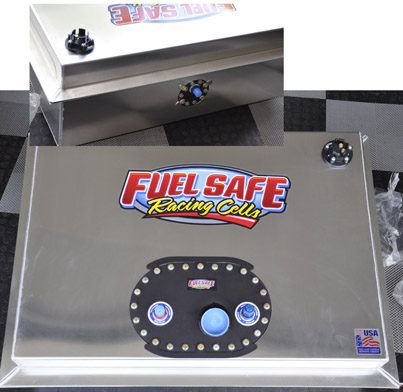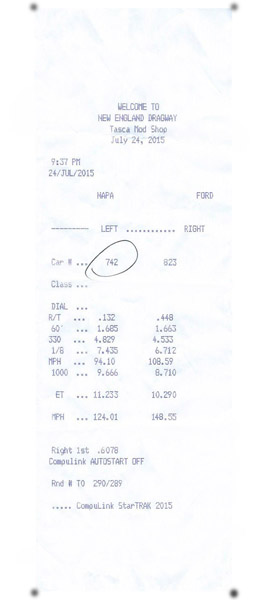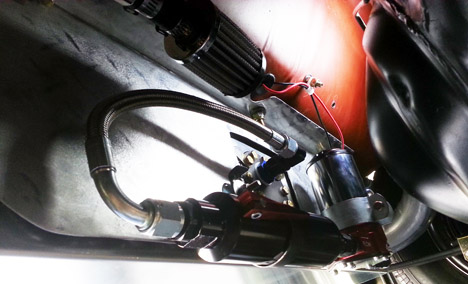|
Build Blog This page last updated 8-4-2015 **** May take some time to load due to many pictures- Please wait***** |
Page 5
May 12, 2015: Chassis Dyno Runs
Catching up this thread with work done during May/June, the car was on the chassis dyno to get a baseline and compare that to the engine dyno run with the same exact timing and jetting to see what the drive line losses were.
This plot shows the % difference in HP and TQ between the engine and chassis dyno results. Note that this is the same jetting, timing, headers with a full 3" exhaust, versus just short stubs with the same 3" mufflers. The main difference now is the driveline, and fuel delivery. As you can see from 3600 RPM's to 5300RPMs the delta is approx. 15% to 18%, then it starts to increase. More on that below.
My guess is you can attribute the % delta below 3400 to just over coming initial frictional losses of getting things going with the driveline, including such things as the tires tightly compressed/deformed on the dyno rollers, and other initial driveline losses. Then it gets into a sweet spot of 15% losses until that 5300 point.
This shows the actual plots from the engine and chassis dyno with same jetting, etc. Overall they track well until you get to the 5300 rpm point.
Increasing the primary and secondary jetting 2 sizes improved this, making the AF richer by about .5 to 1, the HP increased by 12, and torque by 10, along with pushing out the peaks to better align with the engine dyno results
During the run there was a slight breaking up above the 5300 rpm point as evident by the RacePak data. The next plot shows the engine RPM, A/F, Manifold vac, and fuel pressure. Note the RPM jumping around slightly as you get above 5300. At that same point the A/F distinctively gets leaner by about .75 (from 12.5 to 13.3)

Here are more details on the fuel pressure. Even if this is not the main problem
it is a contributor.
 \
\
Now keep in mind this is on the chassis dyno, so there is minimal fuel sloshing. If I had thought of a venting issue at that time, I would of did another pull with the gas cap removed. In any case I do know there is a fuel delivery issue, because with a hard launch (such as at those airport drags earlier in this thread), the fuel pressure drops to 4.6psi, when I hit 2nd gear so a better than stock tank is needed anyway. I would expect a maximum drop of about 1psi.
Entire Fuel system is 1/2" lines from tank to carb
Fuel system:
Gas Tank with 1/2" sender in tank ---> AN-8 braided line---> in-line
fuel filter located just outside of tank--->Solid 1/2" line to engine
bay--->AN-8 Braided line to Fuel pump --->Mechanical fuel pump--->solid
1/2" line---> In-line fuel filter---> AN-8 braided line---> pressure
regulator---> AN-8 fittings to Carburetor
And for your viewing pleasure, here are 3 of the chassis dyno pulls. Crank up the volume!!
It has been a super busy spring/summer and a great way to start the summer was local Nostalgia drag race at an airport that was shut down for the day. A short 330' untreated track, that I could barely hook up on, but still fun.
This was more of a test and tune for me since quite a bit has happened over
the past 6 months including:
- Transmission was completely worked on by Hanlon Motorsports, and it now shifts
great!
- Added the Chromoly roll bar
- Installed the Racepak data logger which has pointed out some things to improve.
- and a number of other things---more on those later....
- Between a number of chassis dyno pulls this spring and the Racepak data, it
turns out that I have had a fuel delivery issue above 5200rpms where the tank
was not venting enough to support the fuel being sucked out through the 1/2"
lines, and with the hard launches and even lots of fuel in the tank, the stock
tank was not cutting it. I have a custom built FuelSafe tank going in this weekend
(Shaun at SoT helped me).
For your viewing pleasure here is a video of a few runs at the airport.
July 17, 2015: Fuel Safe Fuel Cell Installed
This week I installed a Fuel Safe Cell, so that will rule out venting, and slosh from the pickup as with the stock tank The tank has an AN-8 vent, so that will be sufficient t support all of the fuel being sucked out of the 1/2" fuel line. Also had a collector/surge tank with one way check valves for the pickup to take care of the fuel at the pickup during launch. Initial tests show that the erratic high RPM behavior is gone, along with seeing less than 1psi drop in pressure.

Trying to keep a clean look, I trimmed my custom mat to just expose the fill plate and top of the sender in the far back right.

The tank was a super tight fit with the 3" exhaust, especially on the left side. I shifted the tank slightly right, and also had to tweak the tail pipe on the left. Before installing the tank, I reinforced the trunk floor inner lip mounting flange with some 1/8" angle steel since I really did not like how thick the stock flange was, and I wanted something thicker for eh GR8 bolts to attach to.

The AN-8 vent goes into a a length of stainless braided PTFE hose with a loop, and then exits the trunk floor in front of the tank through a bulkhead fitting. I had the tank fitted with a return on the filler just in case I add a return line and bypass regulator in the future. The 22gal fuel safe is higher than the OEM tank, so the fuel filler did not line up perfectly with the tank. I had to trim the filler tube by 2" and then pick up some fuel filler hose. I went with the Goodyear wire reinforced Nitrile rubber hose. They claim it is flexible, but not over such a short distance. Need to use a hair dryer to heat it and form the bend. Once it cooled and set, the bend stayed.

To the left is the vent bulkhead fitting through the floor with a 90 degree AN-8 and a K&N filter. Since I do plan to drive the car on the street every so often, and some tracks I go to are dusty I wanted the filter there to keep from sucking in dust. I had Fuel Safe plumb the surge tank/pickup to the front of the tank to minimize fuel lines going into the trunk, and also use the setup I had with the stock tank. You can see an Aeromotive filter with a shutoff which makes cleaning out the filter and draining the tank a no mess job.
So far with the loop in the vent line, and the filter there is no smell of gas in the garage. The filter is a K&N Crankcase Vent Filter 62-1250, and the stub on the end of it is 1/2" diameter, so it mated perfectly with the AN-8 push loc fitting with a section of 1/2" ID rubber hose.

I will be at New England Dragway next week and will be able to really test out all of the stuff done over the winter.
July 24, 2015: At the track again - New best Time
Well things are getting better and had a new best time and mph. This was after a few runs with lowering the tire pressure to eventually 9psi, and making the rear Calvert rear shocks stiffer with a setting of 8.
It is still having a problem hooking up and in fact most of my 60' times last year were closer to 1.60, however this run was 1.68. Since the 60' was not improved yet the time was better, I am attributing this to the engine breathing better with the new air intake setup, fuel cell and venting, and the minor jet changes I did on the dyno that increased the HP by 12, and torque by 10.
Looking at the data logger (accelerometer G's and drive shaft rpms), I could see that off the line it hooked, then broke loose, then hooked, and then when I hit 2nd, the same thing happened, but to a less of an extreme. During this time the accelerometer hit 1.5G's on the launch, dropped to 0.75G's for a moment, and then when it hooked went back to 1.5G and then slowly went down to 0.75G as I crossed the line.
Spoke with Calvert and they recommended increasing the shocks to 9, and if needed, start to increase the Caltracs preload from 1/4 turn to 1 full turn.

The car in the right lane was a Fox body 408W w/turbo and he blew past me.
The fuel delivery situation is much much better and high rpms are very smooth now, but I am still not 100% happy with it. The data logger showed a drop to 4.7psi at the launch from a normal of 6.8 psi. This was true for both the initial launch, as well as hitting 2nd, and then 5.4psi when I hit 3rd. So rather than waiting till winter, I pulled the mechanical pump am installing an Aeromotive electric fuel pump this week, then hitting the track in 2 weeks.
The fun never ends!
July 31, 2015:Electric Fuel pump install
Just finished the install of the Electric Fuel pump and initial tests indicate less than 1psi change in pressure. Next Friday when I go to the track I will know if it really helped.
I decided on an Aeromotive 11203 pump. From everything I read and after talking with Aeromotive everyone said it is a loud pump, which it is. I made a rubber insulator behind the pump mounting bracket to isolate it, and it does help. However, with the loud exhaust, and as long as I am not just idling, I can barely hear it.
For mounting, I fabbed an aluminum panel to mount the fuel filter and pump to in front of the fuel cell. The panel attaches to the fuel tank lip on the trunk floor. The filter has a shutoff that makes it great for cleaning out the element and fuel cell draining. On the backside of the panel are rubber insulators made out of high density foam and glued to the panel where it rests against the cell to reduce any vibration noise.

The pump 12v is switched through a relay near the battery and the relay control is also connected to an Oil pressure switch to kill the pump when the pressure is below 5psi.